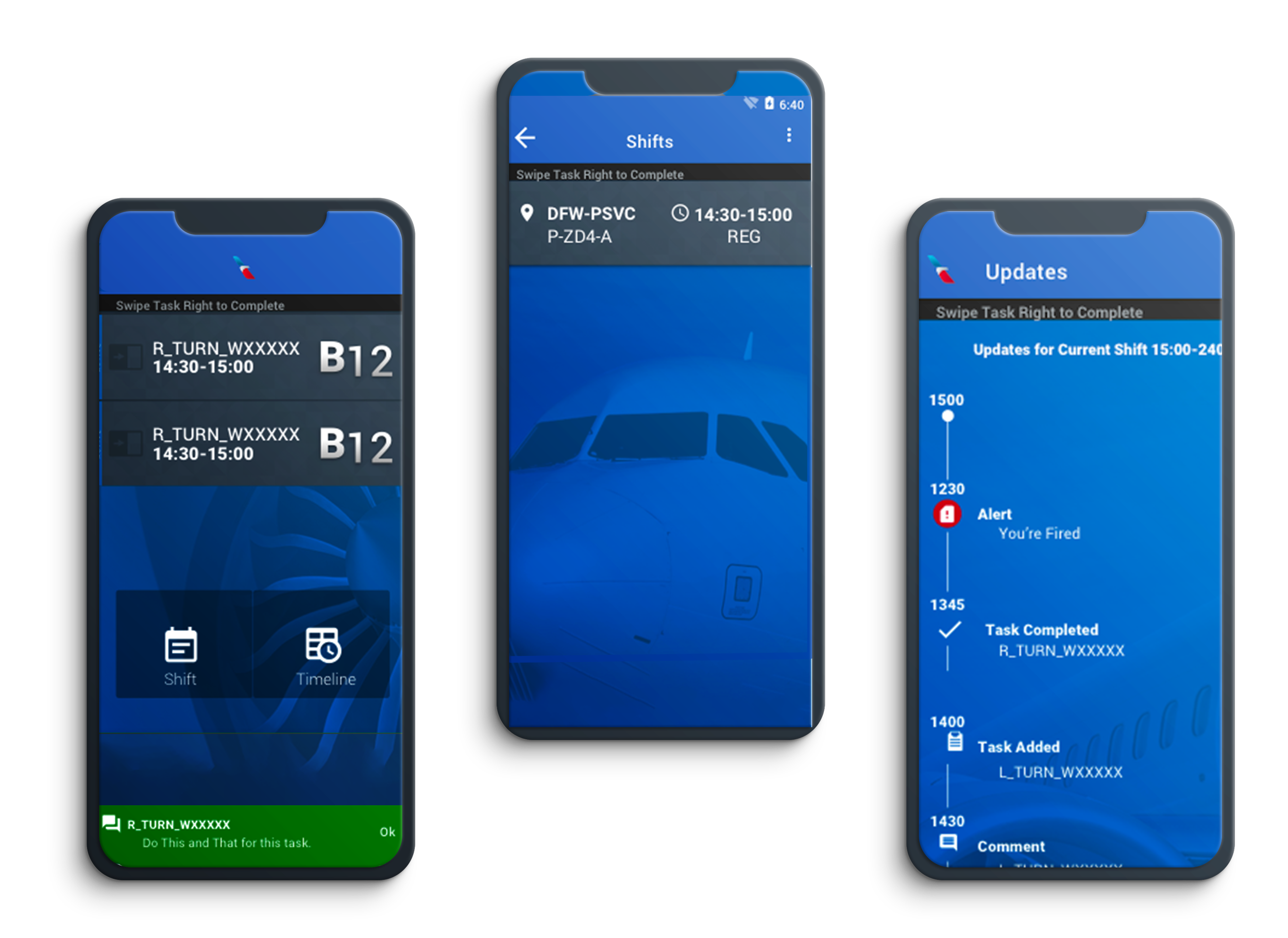Case Study
Designing an Inclusive Airport Service Coordination Platform
Overview
The ROVR app (formerly Dynamic Manning) was rebranded to promote inclusivity and redesigned to tackle key pain points like lack of automation, poor communication, and inefficient task coordination.
Project Duration:
The anticipated duration for project completion is approximately 9 months.
The Problem:
Idle Employees: Individuals without immediate task assignments encounter prolonged waiting periods, leading to inefficiencies.
Communication Gap: Sole reliance on radio communication perpetuates miscommunications, slow communications and inaccuracies.
Glove Compatibility: Certain glove types hinder smartphone interaction, posing usability concerns.
Design Shortcomings: The previous iteration lacked intuitive design, features, and overall functionality. The app also lacked inclusive branding.
The Goal:
The redesign aims to reduce delays, eliminate inefficiencies and increase productivity.
My Role:
As the sole UX Designer, I spearheaded the end to end design process, from user research, interface design and close collaboration with the development team and stakeholders.
Design Process
Process Research: Gain insights into user and stake holder needs, paint points and workflows.
Create Wireframes and Prototypes: Visualize design concepts and gather feedback from stakeholders and users.
Iterate: Incorporate user and stakeholders' input, usability testing and research insights to refine and improve the design.
Create Design Specifications and Guidelines: Communicate design decisions to the development team through documentation.
-
The platform was found to have an unintuitive design, making it difficult for users to navigate and perform tasks efficiently. The lack of clear visual hierarchy, confusing terminology, and complex workflows resulted in a clunky user experience.The platform was found to have an unintuitive design, making it difficult for users to navigate and perform tasks efficiently. The lack of clear visual hierarchy, confusing terminology, and complex workflows resulted in a clunky user experience.
-
One major issue was the absence of real-time data access while employees were out on the field. This lack of immediate information hindered decision-making and caused delays in task execution. Users had to rely on outdated or incomplete data, impacting their ability to perform their tasks effectively.
-
The audit revealed that many users primarily relied on radio messages for direction, instead of utilizing the platform. This indicated a lack of trust in the platform's capabilities and suggested that it failed to provide a compelling alternative to traditional communication methods.
-
The design should be simplified, ensuring clear visual hierarchy, intuitive navigation, and concise terminology. This will help users understand the platform's functionality and perform tasks more efficiently.
-
Enabling real-time data access, especially while employees are out on the field, is essential. This can be achieved by integrating with relevant systems and providing up-to-date information on aircraft status, task progress, and other critical data.
-
Improving Mobile Experience: Enhancing the mobile experience is crucial, considering that employees often rely on mobile devices while on the go. Optimizing the platform for mobile use, such as responsive design and a mobile-friendly interface, will provide a seamless and convenient user experience.
-
Building User Trust and Confidence: The platform should be designed to instill trust and confidence in its capabilities. This can be achieved by addressing the pain points identified in the audit, providing a reliable and intuitive platform that meets user needs and surpasses their expectations.
Refined goals
Overhaul Communication:
Integrate into ConnectME platform.
Automate task assignment and login.
Provide wearable devices to employees.
Standardize assignment nomenclature.
Redesign:
Add wearable device access.
Adopt an inclusive name to reflect diversity.
Adapt UI to perform well in sunlight and while wearing gloves.
Research
initial findings
Pain Points:
No centralized platform for work coordination.
Reliance on manual processes, fragmented information,
and disjointed communication.Platform name "Dynamic Manning" excluded non-male users.
Opportunities:
Streamline workflows with a unified system.
Adopt an inclusive name to reflect diversity.
Improve efficiency and user satisfaction.
Redesign
Users and Stakeholders were asked to provide examples of apps they enjoy. Mood boards and mockups were created from their feedback.
Name Change and Inclusivity:
Select a new name that is inclusive and resonates with the target audience.
Ensure the chosen name aligns with the brand's values and mission.
Update all references to the previous name in branding materials, communications, and platforms.
Wearable Devices and Mobile
Incorporate stakeholder and user feed back on initial designs.
Repeat proces
Brand Strategy:
Define the brand's core values, mission, and vision.
Create a brand positioning statement that communicates the unique value of the product.
Develop a brand personality and tone of voice that align with the new vision.
Visual Identity:
Design a new logo that reflects the updated brand identity.
Choose a color palette, typography, and imagery that convey the desired brand image.
Create design guidelines to ensure consistency across all touchpoints.
Conclusion
In conclusion, the comprehensive rebranding and redesign of the ROVR app stands as a resounding testament to the power of user-centric innovation and strategic transformation. Through meticulous research, thoughtful design, and unwavering dedication to addressing user pain points, we have successfully cultivated a revitalized user experience that transcends mere functionality.
The journey from identifying inefficiencies to creating a seamless, efficient, and inclusive platform has led to tangible results that are reflected in reduced waiting times, improved communication clarity, enhanced task completion efficiency, and a newfound sense of empowerment among employees.
This transformative endeavor underscores the potential of design-driven solutions to reshape not only digital landscapes but also the very fabric of the work environment, fostering inclusivity, productivity, and a shared commitment to excellence. As we celebrate this accomplishment, we are reminded that the pursuit of user-centered design is an ongoing evolution, one that continues to enrich the lives of individuals and the success of organizations alike.











